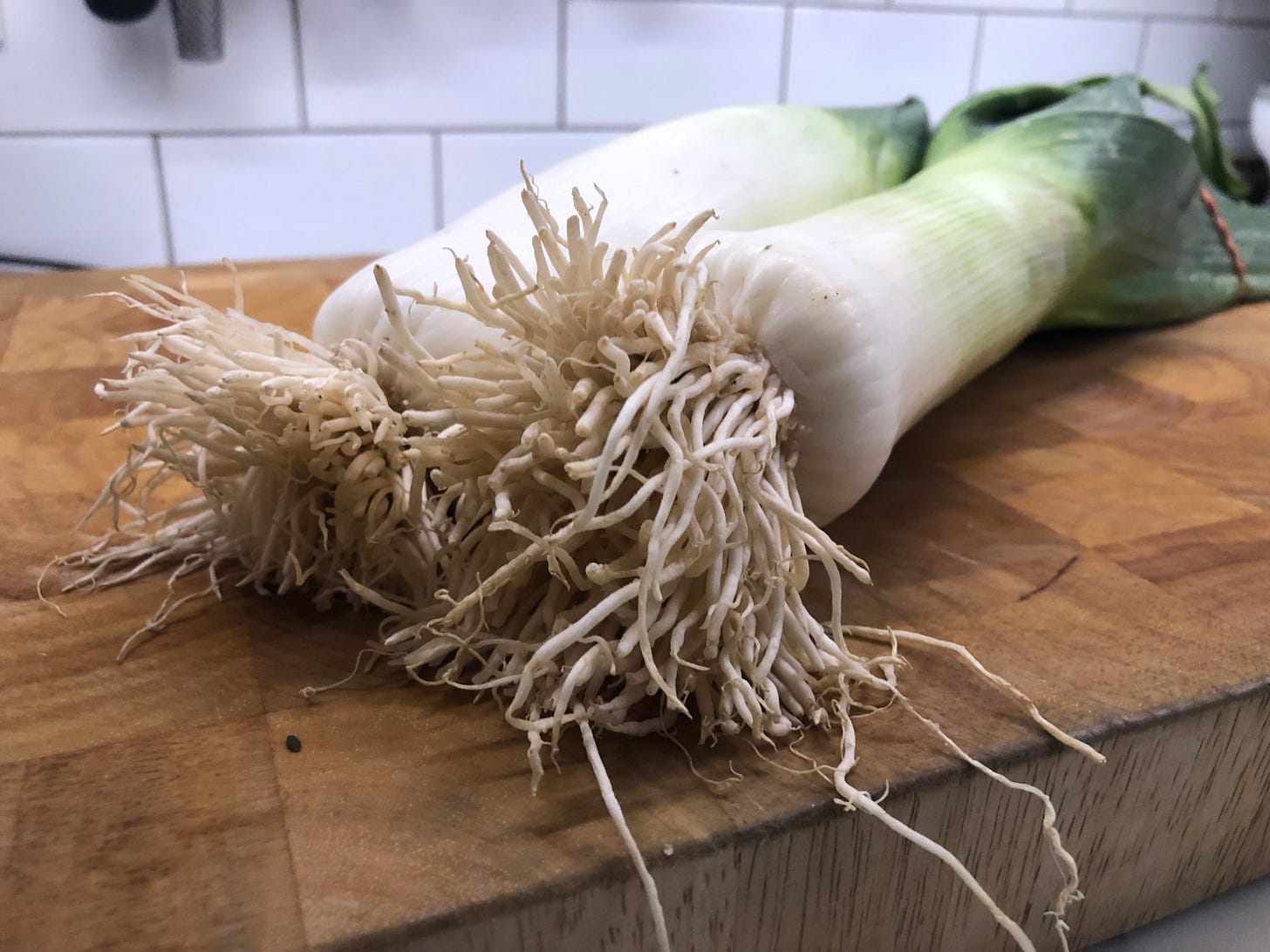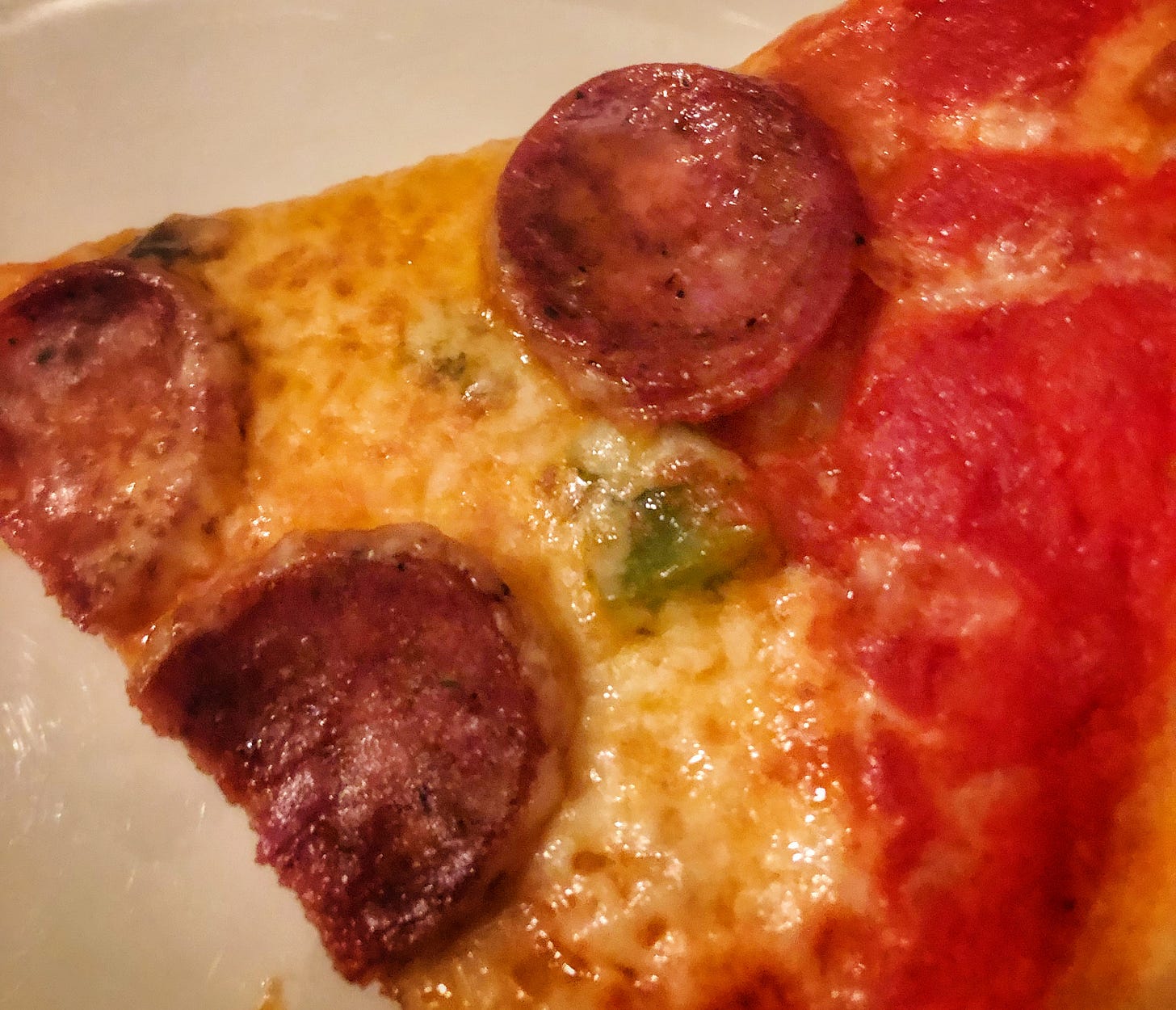23. Medium is the Message
And the message is "good luck getting this recipe right"!
A traditional Alsatian dish seemed like the right thing to make for dinner before attending a Grape Witches education hour about the wines of Alsace. The relentless meat onslaught of a Choucroute Garnie seemed like it might be a bit much. Instead, I decided to prepare Baeckoffe (or Bacheof or Backenoff1), a stew made with beef, pork, and lamb that is a slightly less relentless onslaught of meats. (There is also carrot, onion, leek, and wine.) The lid of the dutch oven it’s prepared in is sealed shut with bread dough and then it’s baked low and slow for three and a half hours.
I have never eaten Baeckoffe, let alone prepared one. I have watched the very few videos in English about making one, and one in French from VinsAlsace.com featuring someone with very questionable knife skills and choices.
Ultimately, I chose a recipe published by Saveur, mostly because it seemed a little simpler and straightforward, although possibly not as authentic. And it wasn’t until I started prepping—there is a two-day marinade—that I noticed a phrase that should have made me keep looking for a different, better recipe: “2 medium yellow onions, thinly sliced.” Also, “2 medium carrots, thinly sliced,” and “2 small leeks, thinly sliced.”
Ugh.
Give me a bunch of onions, and I can easily pick out a medium one, so my objection isn’t that I have no way of knowing if my idea of a medium onion is the same as the recipe writer’s.2 I find “one medium onion” frustrating when, as it happened this time, I could only find very small onions and very large leeks. Without some sort of objective reference, how was I to know what amount of my vegetables to use?3
I know I can google “How large is a medium onion” and get a fairly strong consensus that it weighs about 6 ounces4 and is about the size of a navel orange5, but I shouldn’t have to. If people writing recipes included the weight of the ingredients or even a frame of reference like a grapefruit, their recipes would be more accessible.
And it’s something that can be made even worse when recipes cross borders. For a little while now I have been asking my friends living in the US how big the cabbages are in their supermarkets. Why? Because from what I can gather, the average head of cabbage in the States is much smaller than a Canadian head of cabbage. Martha Rose Shulman’s recipe for Andalusian Cabbage Stew, which I make quite often, calls for “1 small cabbage (about 1 1/2 pounds), cored and shredded or diced (about 6 cups).” (See how easy it is not to confuse your readers?) The smallest green cabbage I could find at Fiesta Farms weighed over 3 pounds and it was the smallest by far. I cook cabbage quite a bit and it suddenly made sense why recipes that were supposed to make 4 servings were yielding enormous batches,6 with far too much cabbage in relation to the rest of the ingredients.
“One medium onion” happens partly because of how recipes used to be written, with a presumption that the people following them have a solid foundation of cooking skills and knowledge. Open up a cookbook like the 19th edition of the Blue Ribbon and Pure Gold Cookbook from 1905 and this is the entire recipe for Roast Duck.
A cook in 1905 would have known what not to stuff the duck too full of. And what a moderate oven is.7 By way of comparison, the recipe for Crispy Roast Duck in Cook’s Illustrated’s The New Best Recipe takes up three very large pages.
If you grew up reading recipes perhaps not as concise as the ones in Blue Ribbon but not as expansive as The New Best Recipe, you grew up with a lot of “one medium onion” recipes, so it’s not surprising if you write recipes that use it. I’ve written recipes with “one medium onion” before, although I don’t any more.
It might seem like I’m complaining that cooks today (including myself, apparently) need to be spoon-fed their recipes because they lack the basic skills people had in the past, but that’s not it. The problem is that too many recipe writers consider only their perspective when they write. Having awareness that someone may only have access to very large leeks or that the size of a cabbage varies depending on where you buy it means you can write recipes that work for everyone.8 And that seems like something we should be aiming for, doesn’t it?
What I’m consuming…
Late to the party,9 but I’m enjoying Meredith Erickson’s Alpine Cooking, courtesy of the library. The photographs alone make me want to buy it. I can’t wait to make her recipe for Rösti in the next few days.
I’ve been a casual fan of Bridget Everett for years, but I was not expecting her performance in Somebody Somewhere. All of the performances are fantastic, actually.
What’s on the menu…
Baeckoffe and Rösti, obviously10.
Not Randy’s Patties, sadly. In November I was crowing that with Randy’s in the neighbourhood, all my patty needs were satisfied. Less than three months later, they announced they were closing. Did I jinx things? If so, I apologize. I haven’t checked out Reidies Patties yet. They opened late last year about 200 metres from Randy’s. At the time I thought that their choice of location was doomed, but instead it seems like it may have been brilliant timing.
Ezzo pepperoni was a revelation for me. It was far, far better than any other pepperoni available in Toronto. And when I became aware that Darren Ezzo was maybe not the greatest guy,11 I was torn—support a shitty person or take a huge step back with my pizza?12 Having bought a huge batch of Ezzo before learning this, I had a bit of a buffer before I needed to make my decision. Happily, Pasture Butchery, a whole-animal butcher in Etobicoke, has started making pepperoni from Linton Pasture Pork and it is fantastic. It cups and chars beautifully and tastes really, really good.
I’ve been very happy with everything I’ve bought from them, which so far includes Toulouse sausages, excellent but expensive hot dogs, and skirt steak. I still loves me some Sanagan’s, but I’m always happy to have more options and a selection of less common cuts.
Or Baekaoffa.
Although, as you’ll see in a few paragraphs, it is partly that.
Onions are the worst for this because the volume of spheres is such a tricky thing to compare. How many “small” onions equal a “medium” one? Two? The volume of a sphere with a 1.5 cm radius is 14.14 cubic centimetres. The volume of a sphere with 3 cm radius is 113.1 cubic centimetres. So it’s not two “small” to get one “medium” it’s more like 8!
On second thought, that seems like a large onion to me. I would have thought a lemon-sized onion was medium.
Even accounting for American portion sizes.
I’m guessing it’s around 375°.
In theory, anyway. Failure is always an option.
And late in the season. The book is heavy on wintry dishes.
Having these for dinner on consecutive nights, it turns out, is tasty, but will also wear you out.
Any single link I could provide would probably confuse more than it would clarify. If you are really interested in the backstory, drop me a line.
See also Bianco DiNapoli tomatoes.





